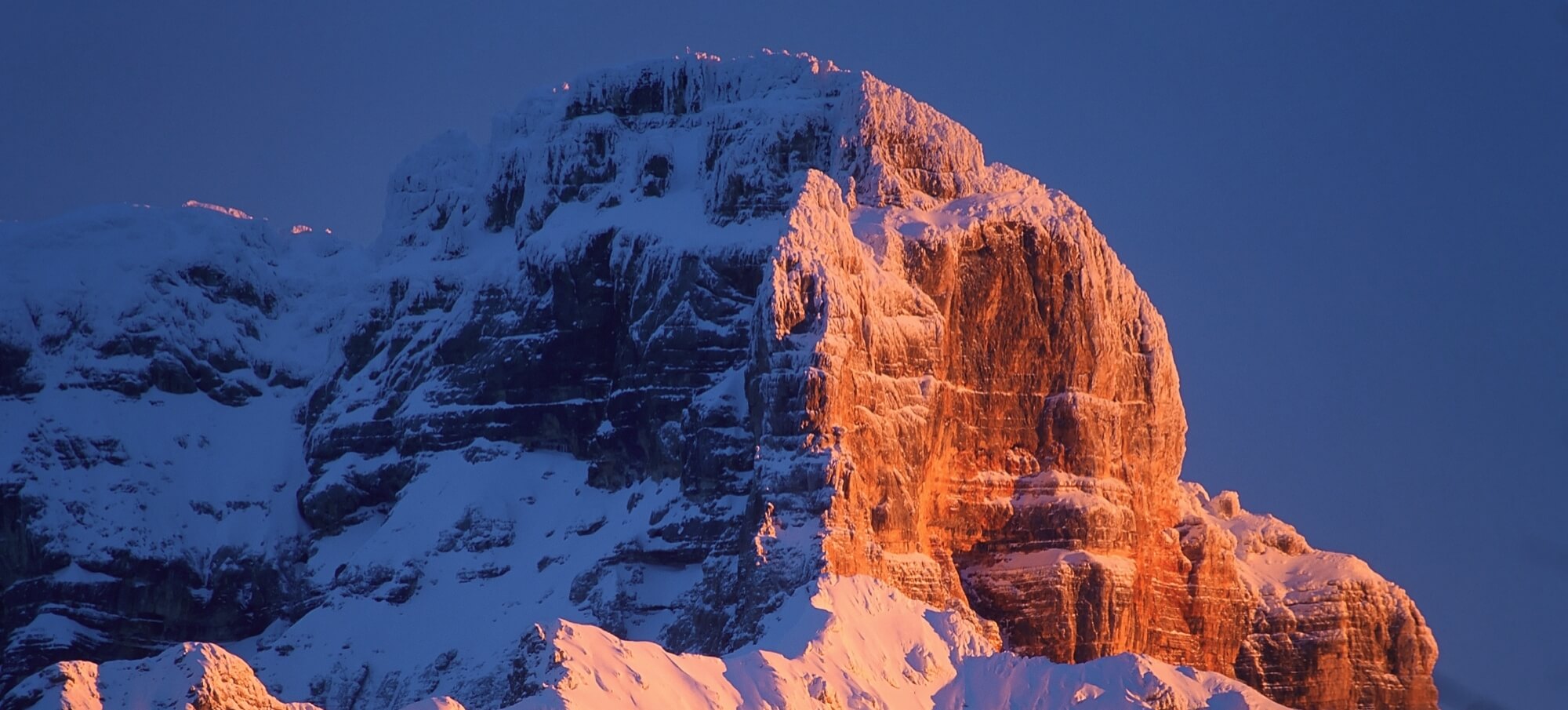A journey of sport and culinary delights: winter in the Dolomites
The Dolomites - Unesco Heritage
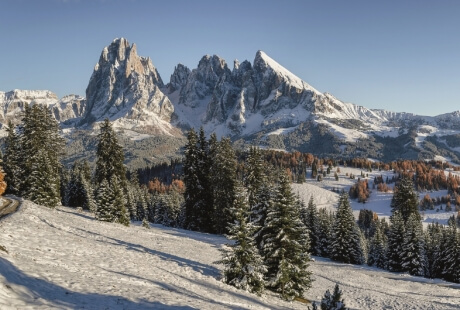
Riveting adventures on the snow, coming up close with the sheer magic of ice or admiring a stunning sunset under a cosy layer of soft blankets, sipping tea from a colourful mug. Winter is a time of silence, of reconnection with our inner self, but also with the surrounding nature, the power of the elements a constant reminder that mother earth is always triumphant. Spending winter in the Dolomites can only be a prelude to fabulous experiences: the natural UNESCO protected heritage, with stunning peaks gloriously rising proud and surrounded by ethereal landscapes, offers something for absolutely everyone.
From the experienced mountaineer to those in search of gentle strolls or easy snowshoe hikes, this stunning area of north-eastern Italy comes with boundless resources and ideas; oh and did we mention local delicacies? They come in droves here and it’s high time you paid your visit to discover the magic.
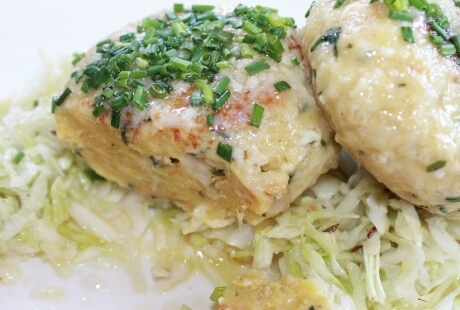
A gourmet valley in the Dolomites - Alta Badia and Val Gardena
Tucked into such a north-easterly corner of Italy as to feel it belongs to a world apart, Trieste – once Tergeste and now known as Vienna by the sea - is elegant, aristocratic and highly original. Boasting an impressive seafront, lined with striking neoclassical buildings, its main square is the meeting place of this cultural hub. Piazza Unità d’Italia jets onto the sea in such a sleek fashion that emotions run high when gazing at the blue expanse in front of you.
For six hundred years under the Austro-Hungarian domination, Trieste was annexed to Italy in 1954. The Habsburg made the city a free port in 1719 and spared no expense in developing this pivotal harbour centre, welcoming trade and business from the Mediterranean. These days, you’ll be spoilt for exciting places to visit, from an ancient Roman theatre – hosting up to 6.000 spectators in its heyday – to one of the tallest lighthouses in the world, the 68-metre high Faro della Vittoria. Sit in one of Trieste’s elegant coffee bars and reminisce about the past: it is said that Joyce penned his famous Ulysses in one of these places! Admire the beauty of the sea from the Rilke trail, a 2-km coastal path that starts from dreamy Duino Castle, loved by Rainer Maria Rilke and Paul Valery, and reaches the Bay of Sistiana; sitting right on the seafront, the castle is privately owned, but visits will show a collection of artworks and terraces that open onto the sea. Noble, romantic 19th c. Miramare Castle can be seen from a distance: strikingly white, it dominates the gulf of Trieste with its ethereal beauty. Do not miss its programme of interesting exhibitions, laboratories and activities for children and adults. Get lost in its lovely gardens, decorated with fountains, statues, rare botanical species and imposing trees, all living in perfect harmony. Above all, however, Trieste is a city that will strike a chord within your heart, inviting you to explore and dig longer into the city’s mesmerizing aura.

Each to their own: living sport at your own pace
Think of a sport and you will find a place in Italy where this is practiced: the peninsula is a nation of proud sportspeople, with a terrain touching all varieties, from jagged mountain peaks to seafaring souls navigating its fascinating seas. South Tyrol is the ideal place for everyone, in the winter and summer alike, with countless opportunities that suit all tasters. You could come and learn cross country skiing – a staggering moonlit race, Moonlight Classic – is held on Seiser Alm in January – ski the fabulous Sellaronda and go round the Sella Group, via Arabba, Corvara, Passo Gardena and Passo Pordoi, among the many ones in a fabulous journey. You may also ride your fatbike on the snow and see the landscape from a different viewpoint: admire the stunning Sassolungo and Sciliar peaks whilst riding on the snow for a buzzy feeling. If you are looking for a gentler activity, why not take up a winter stroll or snowshoe hike and enjoy the magic of snowy pastures in the magical natural parks of Fanes-Senes-Braies, Tre Cime, Puez-Odle or Sciliar-Catinaccio?
Children – and adults alike – will enjoy sledding on the many prepared slopes all around the region. And if you are in search of original, innovative winter experiences in the Dolomites, catch up our list of original suggestions here https://www.claudiadarin.it/10-of-the-best-experiences-in-the-dolomites.html
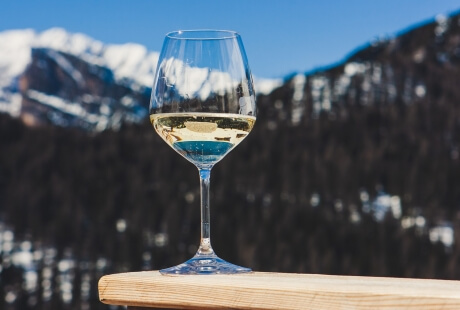
Wines of delight
No gourmet meal feels complete, unless you enrich it with a glass of delicious wine. There are several excellent wine areas across the world, but Italy clearly ranks among the finest for the variety of its stellar production. Looking up close, only a small percentage of wine production comes from South Tyrol, and yet the quality of its labels is astonishing. You will find over twenty grape varieties on an area covering nearly 5,000 hectares of land, with full-bodied Lagrein or character-rich Cabernet and Pinot Noir varieties, for red wines, splendid Gewürztraminer, Sauvignon, Sylvaner or Kerner for a fresh approach to aromatic, white wines.
The 150 km-long South Tyrol wine route goes over sixteen villages and touches on seventy wineries, from Salorno to Nalles and Terlano, with a detour to Bozen. What makes this wine production so unique is the variety of soils and exposures: the fact that vineyards are cultivated at 200m and equally at 1,000m, contributes to a complex mosaic, covering several micro-climates and soils for unique blends and tastes. Admiring the vineyards – clearly tasting local varieties along the way – means enjoying diverse landscapes and sceneries, with serene hills being surrounded by the stunning Dolomites. Organic wines are also a hot trend that has seen a niche market growing in appreciation over the past few years. Closely following the ideas of the Austrian philosopher Rudolf Steiner, among the several practices you will find the use of herbs for special treatments and the respect of lunar phases for harvesting and growing method. True to this system, and pretty much everything else in South Tyrol, is the search for balance and harmony with nature, the undisputed queen of this stunning area.
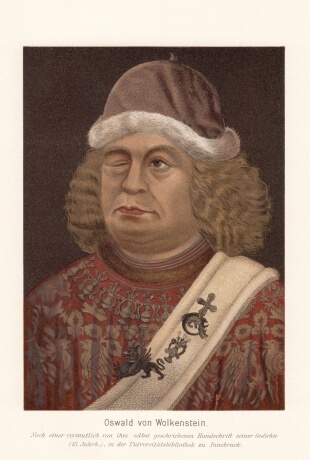
A journey into the Middle Ages
In a country where history resonates in every corner, there comes as no surprise when South Tyrol brings its very own special medieval figures. Chief among them was the one of Oswald von Wolkenstein. Allegedly born in Trostburg, by Ponte Gardena, in 1377, from the age of ten he started travelling across the world and became a knight, a messenger, a poet, a composer and a diplomat to the Holy Roman Emperor Sigismund. His Lieder are said to have influenced German language and are a proof of how highly educated he was – he is said to have spoken twelve languages.
The charismatic figure is celebrated in a horse parade on Seiser Alm that takes place every late spring: here, traditional music is the merry backdrop to the thirty-odd teams that take part in the event. Oswald died in Meran in 1445 and is buried in Neustift Abbey. Go in search of this mythical figure by visiting Hauenstein Castle at the foot of the Sciliar. This is where Oswald composed many of his Lieder and the place is also home to a legend: the castle allegedly hosts one of the entrances to the world of King Laurin!
You will find the castle on the Oswald von Wolkenstein trail on Seiser Alm – best undertaken in the spring and summer – which also goes via the ruins of Salego Castle.
Go in search of truly mythical figure!
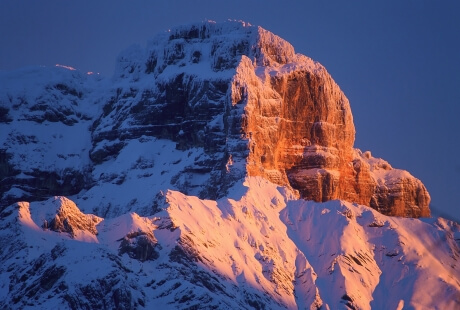
The Legend of King Laurin
Laurino was king of the Dwarfs and his reign,hidden among the rocks of the Rosengarten, was full of marvellous roses. One day, Prince Hartwig decided to marry the pretty Similda. He invited all the noblemen in his reign to take part in a joust, except for King Laurino, who decided to join the festivities nonetheless. When he saw Similda at the joust, her beauty struck him and he fell in love with her, taking her with him. Hartwig then asked the King of the Goths for help and they went in search of the pretty lady, ready to fight for her.
King Laurino had become invisible but, alas, he was detected as they could see him moving among the roses. Laurino blamed the roses, who had betrayed him, and cast a spell on the mountains: from then on, nobody could admire those marvellous peaks during the day and night. He had forgotten sunsets and sunrises, and so from then on, the Rosengarten is bestowed with exceptional rose-tinted colours at dawn and at dusk. Every legend contains some truth… The exceptional Dolomites hues, which stand against the sky and set the scene aflame, are unique.
When will you discover the magic?

Here’s the apple of your eye
Who doesn’t enjoy a juicy apple pancake? Apples are the treasure of South Tyrol and it’s here you’ll want to come to enjoy some of the most appetizing varieties.
This recipe is a sweeter Alta Badia version that elevates the taste of pancakes to a sublime one.
Pössl da pom - Apple pancake
Ingredients
- 150 g flour
- 100 ml milk
- 100ml cream
- 6 egg yolks
- 150 gr. vanilla sugar
- 1 tbsp. rum
- 6 egg whites
- a pinch of salt
- 40g sugar
- 200g apples (preferably bramley) cut into small slices
- oil for frying
- butter
- caster sugar
Method
Preheat the oven to 200° C. Mix flour, milk, cream, egg yolks, vanilla sugar and rum into a creamy dough. Beat the egg whites with salt, add sugar until peaked. Add the mixture to the egg-yolk dough. Heat the oil in a big pan, then pour in the dough, sprinkle in the apple slices and fry until brown on one side. Turn and fry on the other side. Bake for 3 to 5 minutes. Tear into pieces with a fork, sprinkle the powdered sugar over the pancake and then fry for a very short time in a pan so that the sugar caramelizes. Serve on hot dishes with some more caster sugar.
Enjoy!
Travel Tips where to stay
Ask for more info about the best experiences and itinereraries we can design in Tuscany
marketing@claudiadarin.it
All contents, photos and texts are subject to copyright. They are only authorised on my website and social media. Ideas can be a source of inspiration, but any unauthorised use of images and texts is strictly forbidden. All rights reserved.
